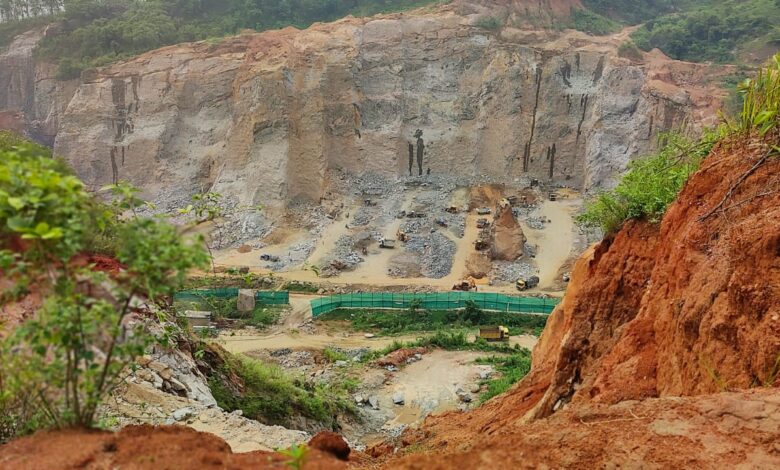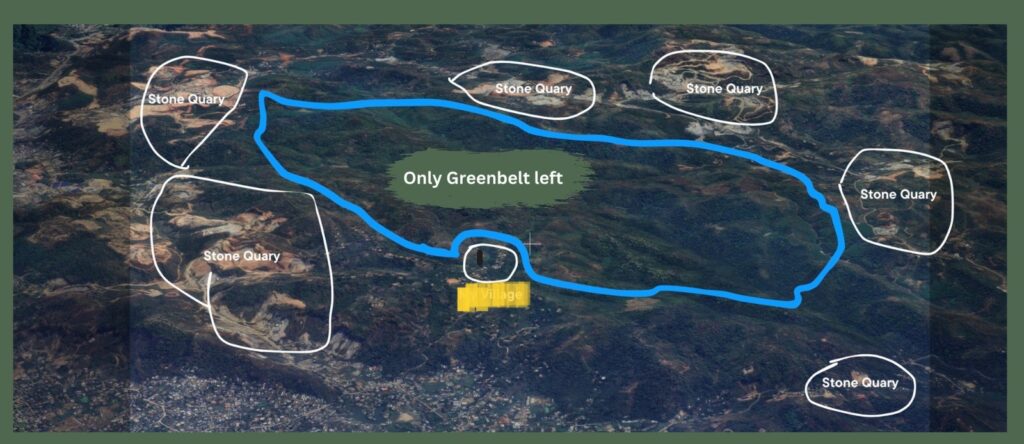Ri Bhoi village troubled by stone quarries
Several quarries near Nongthymmai-Garo are destroying local ecology & disturbing a peaceful life

Nongthymmai-Garo in the Umling subdivision of Ri Bhoi district is a classic example of a village ravaged by human greed and government apathy. The border village, located about 50 km from Nongpoh, is surrounded by “illegal” stone quarries destroying the place’s natural resources.
Stone quarrying in different districts of Meghalaya has affected the environment to a great extent. In February this year, Chief Minister Conrad Sangma said small-scale sand and stone mining could not be exempted without any quarry permit or lease being granted. This is because neither the Meghalaya Minor Minerals Concession Rules (MMMCR), 2016, nor the Mines and Minerals (Development and Regulation) (MMDR) Act, 1957, has any provision for exemption to such traditional practices.
However, he promised fast measures to start scientific mining and grant restricted leases for quarrying. That did not deter quarries from running illegally in the state.
Sunday Monitor visited Nongthymmai Garo village and spoke with villagers to find out how the stone quarries are destroying the forested hills and posing a threat to residents.

Quarrying started near the village in the nineties but stopped for a few months before the Covid-19 pandemic following a National Green Tribunal (NGT) order. Now, these are operating in full steam and violating environmental regulations blatantly.
“A large part of the community forest has been cut down to facilitate quarrying. Also, the hill that was the boundary between the village and Guwahati city is almost gone,” said a villager.
Ironically, the stones being quarried are “sent to Assam” for the booming construction projects in the neighbouring state. On the other hand, the villagers are left high and dry.
Many villagers have leased their land to the quarry operators at a throwaway price. Eric (name changed to protect identity), said he is among the locals who have leased his land. For a 100-foot land, he gets a paltry amount of Rs 9,000 a year. The money is not enough for the daily wage earner to run his family. So, he has taken up menial work in one of the quarries. He is among the three villagers who work in the nearby quarries.
“Most of the villagers are either illiterate or are unaware of the market rate of land. Hence, the quarry owners have taken this advantage to pay a paltry amount to them against the leased land,” said Martin Sangma, a teacher and resident of the village.
Several villagers whom Sunday Monitor spoke to complained that work at the quarries continues even at night, making it difficult for them to sleep. Seren Marak, whose house is located about 200 m from a quarry, said earlier Sundays would be a holiday but now, “work continues even on Sundays”.
“Every time there is a detonator blast, our house shakes as if there is an earthquake,” she said.
Damages from the blast
The vibration reaches even the interior of the village causing damage. On one occasion, a piece of stone flew onto the tin roof of Seren’s house and fell into the house when she was sleeping with the children. “It could have hurt any of us. The tin sheet broke and when we asked for compensation, the quarry management gave us one corrugated sheet to replace the damaged one,” she said.
There are five children in Seren’s house and she fears that the broken stones from the blasts may one day injure them.
Eric, who lives less than a kilometre from a quarry, too had the same complaint. He said big stones fly into the compound of his house every time there is a blast. “The children play outside all the time and accidents can happen any time. His house cracked from the vibration and once the tin roof was damaged. While no compensation was given for reconstructing the damaged wall, the tin sheet was replaced.
The pandemic rendered many daily wage earners jobless in the village forcing them to lease land to quarry owners. Eric has been working as a quarry labourer for 10 years because it is the closest job option for him. “Or else, I have to go to Guwahati for work. We work from 6 am to 4 pm and get Rs 600 a day,” he informed.
Eric’s wife Putuli seconded him. She could remember when the quarries started operating around the village but remembered that these existed in 2000 when she was a 10-year-old child.
Putuli said the house is filled with stone dust and a pungent smell every time there is a blast. “This is causing breathing problems among us. Our eyes are smart from the dust and it becomes difficult to breathe,” she said.
The dust, sound and smell cause various health hazards and are collateral damage to the villagers living near the quarries. There is a need for risk assessment not only for quarry workers but also for those living near such quarries. However, villagers said no measures have been taken to eliminate the health hazards or compensate for health issues.
According to a risk assessment document for stone quarries, blasting should be carried out during the day and at permissible hours. If the blasting operation is near a habitation, there is a need for publicity through announcements and other modes of communication so that the locals are aware of the operation. The vibrations from the blasting should be monitored periodically in consultation with the local mining authorities.
Deep impact on the environment
The Garo-dominated village under the Jirang Assembly constituency has 120 households. The abundant natural resources in the community forest here have always been a source of sustenance for the villagers. “The forest produce helped us survive during the pandemic when nothing was available in the market. We would collect local vegetables and fruits every day,” said Martin.
But quarrying is gradually eating into this forest and destroying the local ecology. The broken hills with little or no green patches, the barren land and the dust-filled path are an eyesore in the village. The place once covered with lust green now stares helplessly at the Guwahati city line that is visible now thanks to the hills denuded of its greenery.
Samnal A Sangma, one of the early settlers of Nongthymmai Garo village, remembered the deep forest that “provided us with food and firewood”.
“The quarries are destroying the green cover. If they keep felling trees at this rate, then the entire community forest will vanish in no time,” she rued.
The Chidilma river, which was the only source of fresh water, has also dried up and villagers barely get any fish. “The quarries are threatening our lives in every possible way. There is no source of fresh water and the stone dust covers every inch of the place. The Chidilma has dried up and there is no water in the pipes laid down under the Jal Jeevan Mission. So, we have to buy water for drinking and other purposes,” said Seren.
Putuli spoke about the same problem and added that plantations were also affected.
According to the Meghalaya Minor Minerals Concession Rules, 2016, “no mining lease and quarry permit shall be granted in respect of any land within a distance of 50 meters from any village, bridge, national highway or water source except with the prior approval of the State Government”.
The rules also restrict quarrying and mining within forests as identified by the Forest and Environment Department, community reserves and in areas falling within the catchment area as defined under the Meghalaya Protection of Catchment Areas Act, 1990.
However, villagers informed that the former headman of Nongthymmai Garo granted NOC to the quarry owners and “we have no say on that”.
Sengsal Momin, the current headman, said even his house was damaged by the vibrations from the blasting. “All villagers are suffering because of the quarries. Every time we think we would complain. But many villagers are afraid to complain to the authorities concerned fearing repercussions,” he told Sunday Monitor.
NGT action

Nababrata Bhattacharjee, chairman of the State Expert Appraisal Authority on Environment, informed that quarrying is allowed only when an environment clearance is granted under the EIA Act, 2006. Also, the Directorate of Mineral Resources has to approve a mining plan for quarrying followed by various approvals by the Meghalaya State Pollution Control Board (MSPCB).
On the stone quarries at Nongthymmai Garo, Bhattacharjee said, “The National Green Tribunal (NGT) banned mining in that belt for 3-4 years… (if these are illegal) action will be taken by the Forest Department and the district administration. We grant EC to those who approach us with all documents.”
It could not be independently confirmed whether the quarries, allegedly run by one Abhinav Surekha of Assam, received the necessary approvals. A Guwahati-based RTI activist, Jitul Deka, said several villagers in quarry-affected villages also told him about Surekha.
When asked, KHADC CEM Pyniaid Sing Syiem said the council sent a team in the past to check illegal mining activities in the area but after the NGT ban, the KHADC waited for the outcome of the case.
The NGT action came after Deka moved the tribunal against the stone quarries in 2018. In his application, Deka said the residual sand dust from the illegal excavation of earth and stone extraction blocked the drainage system in Khanapara causing artificial floods in Guwahati. He also alleged that a ‘stone mafia”, with the connivance of government officials in Meghalaya, was destroying the local ecology.
The NGT took cognizance of the complaint and passed an order in May 2022 where it imposed a penalty of Rs 153 crore on the illegal quarries and asked the state government to collect the amount by April 2024. It also found that 118 quarries were violating regulations.
“The quarries in Killing (Meghalaya) were affecting the city. So, I approached NGT following which an inquiry committee was set up that carried out investigations in the areas up to Rani. The committee found many illegal quarries and submitted the report to the NGT. I visited the areas recently and found that the quarries in the Rani area have stopped functioning. But some are still functioning in Killing. I filed an RTI to the Meghalaya government about six months ago but the reply is yet to come,” Deka told Sunday Monitor on the phone.
Deka said he has been monitoring the situation and trying to identify the illegal quarries. He is also following up with the Meghalaya government about the penalty collection.
A senior state forest official dealing with the NGT case said many cases were filed in this regard and those were disposed of with a direction that those who engage in illegal mining should pay compensation. When asked about Deka’s case, the official said it was disposed of but “the compensation part is still pending”.
R Nainamalai, chairman of the Meghalaya State Pollution Control Board, said he asked the Divisional Forest Officer (DFO) to visit the place and submit a report.
Earlier, DFO Arul G. Mathuram had told Sunday Monitor he would seek a report on the mining activities in Nongthymmai (Garo).
Not many villagers, like Eric, are aware of the NGT ban or government regulations on stone quarries. “I understand that the quarries are harming our environment and adversely affecting our lives but I am helpless. What can I do alone? If everyone in the village protests against the quarries, I will join them,” he added.
At a juncture when illegal quarries are destroying the local ecology and adversely impacting the locals’ lives, the state government should step up and take action. It should immediately start an inquiry into these stone quarries, penalise violators and ask for compensation for affected villagers. A delay in doing so will only prove its connivance with the rule breakers.
~ Team Sunday Monitor





